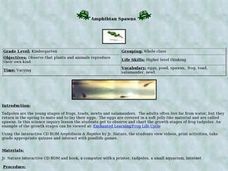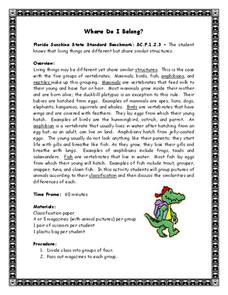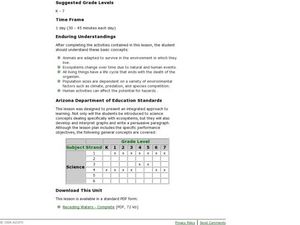Curated OER
Reptiles and Amphibians
Introduce your class to various reptiles and amphibians. They will meet and identify a representative from each of the four major reptile families, then learn about and discuss reptile characteristics. Next, they will identify and...
Curated OER
Word Search: Common Amphibians and Reptiles
Youngsters find these common amphibians and reptiles in this word search. Each of the animals has an accurate representation on the worksheet. There is an answer key at the bottom of the page. A nice, colorful word search.
Omaha Zoo
Monitoring Amphibians
What sort of shoes do frogs wear? Open toad sandals. If your scholars want experience collecting field samples, this is the lesson for you. After learning the proper way to collect field samples, pupils catch amphibians to test for...
Curated OER
What Class Are You In?
Classifying animals has never been this much fun! Pupils discuss the animal groups, fish, reptiles, amphibians, mammals, birds, and also identify their characteristics. Then, they take pictures of animals and classify them in a group...
National Science Teachers Association
Hop into Action
Young scientists find out what makes amphibians such unique and interesting animals in this simple life science lesson. After looking at pictures and discussing the characteristics of amphibians, learners complete a series of three Venn...
Curated OER
Reptiles and Amphibians
Fourth graders explore biology by viewing animal videos in class. In this amphibian and reptile lesson, 4th graders identify the key differences between reptiles, amphibians and other animal classifications. Students view video clips in...
Curated OER
Creating a Dichotomous Key for Amphibians
Students are introduced to the purpose of dichotomous keys and create one together as a class. In groups, they use a digital atlas to examine the different types of amphibians in Idaho. Using this information, they make their own...
Curated OER
Amphibian Spawns
Students observe tadpoles as they gradually change into adults. In this amphibian biology lesson, students watch tadpoles in a tank in the classroom, keep a daily record of what they observe, and chart the growth development of the...
Curated OER
The Five Classes of Vertebrates
What a terrific lesson! Learners discuss the animal kingdom, and classify them as vertebrates and invertebrates. They also identify them as fish, amphibians, reptiles, birds, and mammals. There is even a taxonomic breakdown of popular...
Curated OER
Who Am I?
Young biologists can see a variety of animals, amphibians, mammals, insects and clearly identify them. They match up the animals' names with the picture. The pictures are clear and colorful! A very nice worksheet for early elementary...
Curated OER
Word Search: Australian Reptiles & Amphibians
For this word search worksheet, young scholars will find and circle the names of 21 Australian reptiles and amphibians. A realistic, color picture accompanies the name of each animal.
Curated OER
Dress Like A Frog
Students recognize amphibian adaptations. In this amphibian lesson students explore amphibian adaptations that provide for successful living in their environments. A volunteer dresses up with all of the adaptations using everyday items...
Curated OER
Where Do I Belong?
Fourth graders work in groups. They are given magazines. Students cut pictures of five mamals, five birds, five reptiles, five amphibians, and five fish. They place the pictures in a plastic bag. Students switch bags. They are explained...
Curated OER
Frogs
Students explore the external and internal structures of an amphibian and how frog anatomy compares to human anatomy. They collect pictures of a frog using a digital camera, create a web page, develop a PowerPoint presentation, and...
Curated OER
Receding Waters
Young scholars explore the effect of environmental factors on ecosystems. In this wildlife and ecology lesson plan, students identify and describe the stages in a frog's life cycle. Young scholars participate in a simulation...
Curated OER
Name Scramble
In this name scramble worksheet, students practice unscrambling the names of ten reptiles and amphibians for spelling mastery of these animals.
Curated OER
Types of Animals
Learning about animals, and their classifications, is a regular part of the elementary-school curriculum. Using this presentation, learners can review information relating to animal classification, and test their knowledge. This would be...
Larson Lab
Animal Classification
How are animals classified? Scholars explore animal classification by observing non-living and living specimens. They learn how to organize animals into vertebrates and invertebrates and identify the five vertebrate groups: mammals,...
Curated OER
Who am I?
Here's a worksheet that has a variety of animals pictured. Learners must cut and paste the correct name and glue it in the box with the pictured animal. Great for young learners. An answer key is included on the worksheet.
Curated OER
Up, Down and Dirty: Exploring Birds and Amphibians in the Victory Bog
Students discover how to use a field guide for birds as well as observing them via binoculars. They gain an understanding of the role of bogs and their inhabitants, specifically the Victory Bog. They create their own field guides.
Curated OER
Tadpole Diary
Second graders examine the life cycle by observing tadpoles. After reading the book, Tadpole Diary, they draw the stages of tadpole development and write sentences about what they think is happening.
Curated OER
Animals Galore
A well-designed instructional activity which covers the characteristics of the animals found in the six animal groups is here for your young biologists. In it, learners divide up into six groups; the amphibians, reptiles, mammals, birds,...
EngageNY
Science Talk: How do Bullfrogs Survive
Following the reading of the book Bullfrog at Magnolia Circle, the ninth lesson in this unit involves emerging experts in a science talk about how bullfrogs survive. Looking back through the text, young scholars prepare for the...
Curated OER
Soak it up
Young scholars complete a hands on activity using hard boiled eggs, food coloring, tape, cups, water, and a knife to show how permeability affects animals. For this permeability lesson plan, students complete this activity and learn how...
Other popular searches
- Reptiles and Amphibians
- Amphibians With Worksheets
- Fish and Amphibians
- Reptiles Amphibians
- Amphibians and Reptiles K 2
- Frogs and Amphibians
- Reptiles & Amphibians
- Animal Needs Amphibians
- Amphibians That Hibernate
- Amazing Amphibians
- Types of Amphibians
- Amphibians With

























